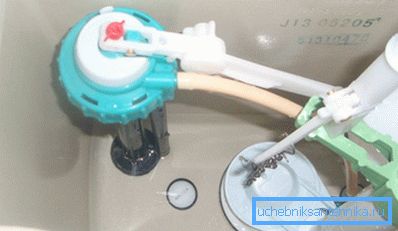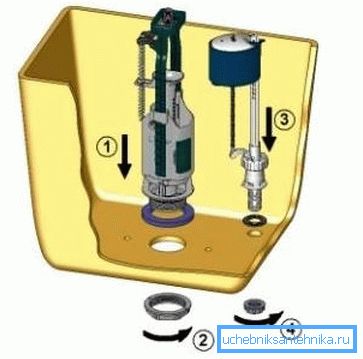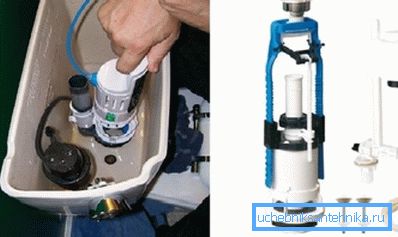What are the insides of the toilet bowl and their repair
The main element of the modern toilet bowl is the drain tank. Anyone who does not want to pay money to service companies for simple work should know his device and how to solve possible problems. Trading networks today offer a large number of cisterns, therefore, today we will tell you how not to get lost in such a variety.
You will get acquainted with this type of sanitary equipment and a variety of its viscera.

What are the differences between toilet flush cisterns?
There are enough factors by which one equipment does not look like another, the first is the material from which they are made:
| Metal | The lifetime of the equipment is long, however, they have not the most aesthetic appearance. |
| Plastic | Low weight, easy installation. The disadvantage is that they can be easily damaged. |
| Ceramics | Most Popular. Reliable and do not differ installation complexity. Today, customers are offered a variety of color variations and shapes. |
The second difference is the type of trigger device, which can be side and top.
- The first can often be found in various institutions, including schools, public buildings, universities. The trigger mechanism is an ordinary chain, fixed on the tank itself, placed at a certain height from the toilet bowl. Its principle of operation is as follows - it is necessary to pull the chain, which pulls the lever behind it, at the other end of which the cork with the gasket is lifted, after which water begins to flow into the drain pipe.
- Upper type - a special head or button located at the top of the tank lid. It is this option trigger is now the most popular. It works like this - after pressing the button a rubber bulb rises, and water begins to flow into the drain pipe.

There are also differences in the type of trigger - it can be manual or mechanical. In the latter case, the instruction allows all adjustments to be carried out without user intervention. In the case of a manual type, the tank valve will open only at his request, which makes it possible to regulate the use of the amount of water for flushing.
Other separation methods
In addition to the above, the drain tanks are also divided by:
- installation option;
- way to flush.

Consider the installation:
- The container is placed almost under the ceiling and is connected to the toilet with a long fitting.. The appearance of the installation in this case is far from aesthetics, but at the same time there is a maximum water pressure.
- The second type of installation - the container is attached directly to the toilet.. This method is considered the most preferred and does not incur much costs than the following. The kit is quite compact and with an attractive appearance, it is also convenient for repairs.
- The third type is a flush cistern built right into the wall.. Due to this, it is possible to free up space in the toilet room and improve its appearance. The disadvantage is the complexity of installation and repair work.

We will deal with the drain:
- Direct flush - in this case, water begins to flow into the toilet directly from the cistern. Changing the direction of its movement is not provided.
- Reverse flush - in this case, a change in the direction of water during flushing is envisaged. Dignity - the most functional way. Disadvantages - more noise is created due to the same functionality.

How does the tank drain
The shape, device and color of the equipment may vary depending on the material of its manufacture. One thing remains unchanged - the device must collect and discharge water. To ensure the process allows the internal structure of the drain tank.
Most often it has 2 main mechanisms - the supply and discharge of water, which in turn are divided into:
- the float and its valve;
- pear;
- overflow;
- leverage.
They can be made from different materials, be different in shape, have different ways of connecting with each other, but their essence and principle do not change.

Water supply
- The armature is located on top, water enters the tank through the side channel. On one side of the lever there is a float and, when the water reaches a certain level in the tank, the lever on the other side will press on the rod and block its flow through the membrane. The method is often used by domestic manufacturers. The disadvantage is a lot of noise during the set of capacity.
- Water supply from the bottom of the tank. In this case, the float for the toilet bowl moves directly along the vertical rod, energy is transferred to the membrane when it is moved by means of thrust. Last and regulates the movement of water in the tank. In this case, the noise is minimal or completely absent.
Most often today use the second option. In this case, the drain tank is equipped with a push-button mechanism, often for two modes - 2-4 liters and 6-8 liters.
In public places you can find automatic drain systems. They are more hygienic, as it does not require touching the elements of the mechanism.
They react to movement. The disadvantage is the high price of devices.
Principle of operation
We will understand in more detail how the device works:
- After pressing the button, the drain system is started.
- At this moment, the stem is activated, raising the pear.
- The pear opens the shut-off valve of the drain mechanism, through which water begins to flow into the toilet and sewer.
Tip: remember that the process controls the control valve to drain water from the tank. Its structure depends on the design used and can have its own distinctive features.
Of course, the drain tank, like any other equipment, can break during operation. It has weak elements that can wear.
Main problems:
- water incontinence in the tank;
- slow filling of the tank;
- excessive amount.
Repairs
Water incontinence
One of the main reasons is water overflow. You can solve the problem with your own hands by adjusting the overflow level. To do this, set the float so that the flow stops below the overflow.
Another reason is the water shut off valve.
There are two ways to solve the problem:
- Replace the old rubber membrane with a new one.. In this case, it is not necessary to disconnect the drain tank from the toilet bowl. Remove the upper part of the drain mechanism and carry out the necessary actions. The cost of the membrane is small.
- Clean the valve of debris that usually accumulates under it.

Water flows slowly
A common problem is that the overlapping membrane is clogged. To solve the problem, it is necessary to clear the hole for water supply to the tank. Prepare to work nippers or pliers.
Tip: carefully disassemble the mechanism of the membrane, it is better to take pictures or sketch out the stages so that during the assembly everything is set in its place.
Plenty of water flows
Solving the problem - adjust the level of water supply, while paying attention to the float. For side feed, adjust by loosening the lever nut in order to lower the water level with the float to the required level.
If the feed is lower, level the float using plastic thrust. Perform manipulations until it reaches the desired level.

The remaining problems will have to be solved by replacing old parts with new ones.
Conclusion
Virtually all of today's manufactured drain tanks have a float valve that regulates the water supply, a flush button, drain fittings, and a cap. Structurally, this list may change, but the main components and the principle of operation will remain the same (see also the article What to do if water runs in the toilet: how to repair the tank and not drain money into the sewer).
Most often, repairs are made independently by the usual adjustment, in difficult cases it is better to replace the old parts with new ones. The video in this article will provide an opportunity to find additional information on the above topic.